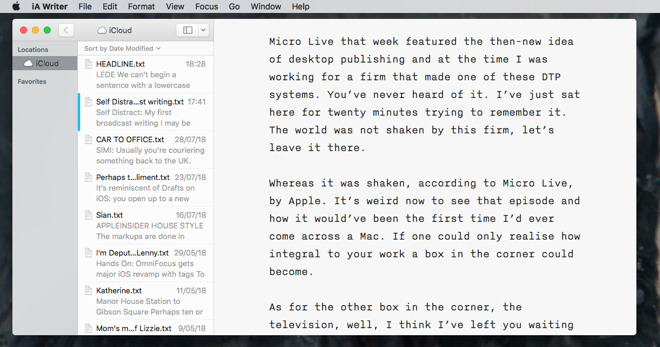

#THE SWEET SETUP IA WRITER MOVIE#
The choices ahead of us are epochal, because there is an obvious temptation for movie producers to choose the low road of “just automate everything you can.” This approach may be profitable in the short term if it allows for more shows to be cheaply produced, with fewer screenwriters, actors, and other staff.īut studio profits and high-quality output are not the same thing. If they fail, other knowledge workers will stand even less of a chance of shaping the future of work and technology. For starters, Hollywood’s creative workers are uniquely well-organized and powerful compared to workers in other industries. There are grounds for thinking that the WGA strike could be more important even than the struggles for union recognition at Ford and GM’s factories a century ago. Knowledge workers - and, indeed, all workers - should hope that the WGA and its members succeed in showing not only how unions can raise wages in the short term, but also how technology can be used to support creativity, rather than simply displacing it.

Striking WGA (Writers Guild of America) workers picket outside Netflix offices. Should powerful new technologies be used to automate knowledge work and sideline workers? Or could AI become a tool to boost worker productivity and creativity? Much will depend on whether workers have a voice, and on how such choices affect productivity and product quality. Leading tech-focused companies face many of the same choices that car manufacturers had to make at the beginning of the 20th century.
#THE SWEET SETUP IA WRITER HOW TO#
Today, we are confronting equally revolutionary changes, now that executives are considering how to apply generative AI to all components of knowledge production and distribution. Productivity growth (not to mention shared prosperity) would have suffered greatly as the human contributions to technical work, design, maintenance, inspection, and creative problem-solving were undermined or lost. Imagine what would have happened if manufacturing companies attempted to adopt “workerless factories” in the 1950s, as some had started advocating. Both employers and employees benefited from the productivity gains.ĪI poses significant threat to Irish jobs, says report Part of what made this possible was an emphasis on continually training and upskilling workers to handle new tasks. Over several decades, the new balance that developed between management and workers in car manufacturing contributed to rapid wage growth. The famous sit-down strike at GM in 1936-37 was a key step in achieving union recognition, improved working conditions, and higher compensation for workers. By 1929, Ford and GM were each making 1.5 million cars annually (with total US auto production around 4.5 million), and the industry employed more than 400,000 people. In 1899, the US car industry employed a few thousand workers, producing around 2,500 vehicles per year. These tasks expanded workers’ contribution to production and translated into a big increase in the demand for labour. While Ford and his contemporaries certainly did automate some processes, their improved factories also introduced a lot of new activities that required human labour - from material preparation and machine maintenance to co-ordinating operations.

These are the two pillars of shared prosperity. On the contrary, that did not happen until new tasks had been created, and until workers had acquired enough bargaining power to demand higher wages. But workers did not automatically share in these gains. Henry Ford, a pioneer in applying these technologies, estimated that motor-enabled machinery “alone has probably doubled the efficiency of industry", while also making it possible to build much larger factories. In the early 20th century, rapid improvements in manufacturing technologies such as moving assembly lines and electrical machinery led to a sharp increase in productivity.


 0 kommentar(er)
0 kommentar(er)
